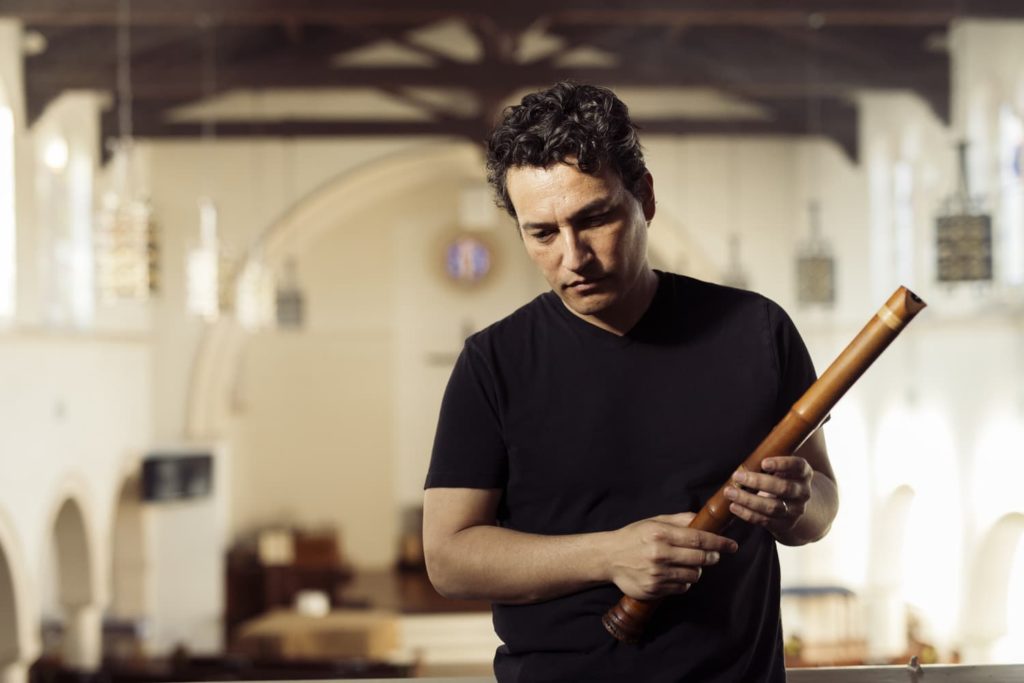Imaginative and Eclectic, Art of Elan Soars at The Mingei International Museum
Inventive programming is Art of Elan’s calling card, but Thursday’s program at the Mingei International Museum proved particularly eclectic, even by Art of Elan’s standards.
Kojiro Umezaki opened the concert with an extended shakuhachi solo, “Soukaku Reibo,” followed by Mitchell Carlstrom’s six-movement percussion solo by the late Finnish composer Kaija Saariaho, “Six Japanese Gardens.” Then twenty members of the San Diego Children’s Premier Choir under Artistic Director Ruthie Millgard took the stage to sing three songs by Ilse Weber, followed by the Hausmann Quartet and Umezaki playing Umezaki’s quintet “(Cycles) what falls must rise.”A traditional Japanese wooden flute, the shakuhachi is most similar to the Renaissance recorder, although the shakuhachi has a more robust timbre, and—in the hands of a virtuoso like Umezaki, a regular member of Yo-Yo Ma’s Silkroad Ensemble —it is capable of more subtle nuances of phrasing. “Soukaku Reibo” opens with a series of short, slow calls that develop into more complex and even dramatic figurations as the piece progresses. I was impressed with Umezaki’s dramatic trills, animated by the subtle shaking of his whole body, not just his fingers on the instrument.
Umezaki’s quintet “(Cycles)” explored two moods, a sonic cloud of soft, transparent lines from the violins that supported the shakuhachi’s equally finessed themes and an invigorating, even rhapsodic adventure in which the cello and viola engaged in muscular counterpoint with a bass shakuhachi. The Hausmann Quartet brought their trademark sonic warmth and sensitivity to the style of this unusual assignment. Kudos to cellist Alex Greenbaum and violist Angela Choong for their admirable accounts of composer Umezaki’s jubilant themes and to violinists Isaac Allen and Bram Goldstein for their deft understatement. As the shakuhachi soloist, Umezaki proved as an ardent and ingratiating ensemble player. I particularly enjoyed the quintet’s rousing, dance-like finale.
I should confess that I approach a long solo percussion piece with some trepidation. Fortunately, Saariaho crafted a winning digital sound component for “Six Japanese Gzardens” that elegantly cushioned or complemented Mitchell Carlstrom’s bravura execution of her percussion tour de force.
While short sections of actual vigorous drumming are scattered throughout the piece, most of Carlstrom’s art involved understated taps and animated ostinatos on smaller, brighter percussion instruments.
The well-trained treble voices of the San Diego Children’s Premier Choir communicated gracefully the soothing melodies of Ilse Weber’s three lullabies, accompanied by the Haussmann Quartet. The skilled choral and instrumental arrangement of her themes was accomplished by Sharon Monis and Jacob Herrera. Of course, it is impossible to hear this lovely music without experiencing its devastatingly poignant context. A successful Czech author in the 1930s, under German occupation of her country in World War II, Weber was sent to the Terezin concentration camp, where she sang these songs to frightened children. She and her younger son were killed in 1944, but an older son had safely escaped Czechoslovakia in a Kindertransport to Sweden.
This concert, “Maps and Memories,” was presented by Art of Elan at the Mingei International Museum on Thursday, October 19, 2023.

Ken Herman, a classically trained pianist and organist, has covered music for the San Diego Union, the Los Angeles Times’ San Diego Edition, and for sandiego.com. He has won numerous awards, including first place for Live Performance and Opera Reviews in the 2017, the 2018, and the 2019 Excellence in Journalism Awards competition held by the San Diego Press Club. A Chicago native, he came to San Diego to pursue a graduate degree and stayed.Read more…

